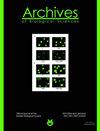向日葵(Helianthus annuus L.)幼苗下胚轴致光弯曲响应的日光周期和节律性
IF 0.8
4区 生物学
Q4 BIOLOGY
引用次数: 1
摘要
向日葵(Helianthus annuus L. cv.)致光性弯曲的研究。本文介绍了Kondi (Syngenta))幼苗下胚轴的昼夜光周期和自由光周期的比较,目的是解释昼夜节律性的发展。与恒光(CL)条件下均匀的PT弯曲响应相比,在所有昼夜光周期中,PT弯曲幅度和滞后相位持续时间表现出强烈的日节律性。实验中,植物的PT弯曲强度在白天中午左右达到最大值,在黄昏后4小时开始的植物在黑暗时期达到最小值。植物可以弥补昼间光周期在白天持续时间上的巨大差异。他们需要前4小时的黑暗来恢复和同步PT弯曲,并开始增加PT弯曲的幅度。滞后相位持续时间的日变化模式相似但相反,表明同步也发生在夜间。在CL条件下,PT弯曲不需要黑暗,然而,在白天的光周期中,它可以在需要时建立昼夜节律和PT弯曲能力的同步变化,在中午提供最大值,在夜间提供最小值。在与CL条件开始相对应的延长的白天时间下,植株迅速放弃昼夜节律调节,其PT弯曲反应变得不规律。本文章由计算机程序翻译,如有差异,请以英文原文为准。
Diurnal photoperiods and rhythmicity of the phototropic bending response in hypocotyls of sunflower, Helianthus annuus L. seedlings
Research on phototropic (PT) bending in sunflower (Helianthus annuus L. cv. Kondi (Syngenta)) seedling hypocotyls presented herein focused on a comparison of diurnal and free-running photoperiods with the aim of explaining the development of diurnal rhythmicity. PT bending magnitudes and lag phase duration exhibited strong daily rhythmicity in all diurnal photoperiods, contrasting with the uniform PT bending response to constant light (CL) conditions. Plants had a daytime maximum for PT bending magnitudes in experiments starting around midday and a minimum in the dark period in those starting 4 h after dusk. Plants could compensate for large differences in the daytime duration of diurnal photoperiods. They required the first 4 h of darkness to recover and synchronize the PT bending and to start increasing the magnitudes of PT bending. The daily pattern of lag phase duration changes was similar but inverted, showing that synchronization also occurred during nighttime. Darkness was not required for PT bending under CL conditions, however, during diurnal photoperiods it enabled the establishment of diurnal rhythmicity and synchronized changes in PT bending capacity to occur when needed, providing maximal values at midday and minimal during the nighttime. Under prolonged duration of daytime corresponding to the start of CL condition, plantlets rapidly abandoned circadian regulation, their PT bending response becoming arrhythmic.
求助全文
通过发布文献求助,成功后即可免费获取论文全文。
去求助
来源期刊
CiteScore
1.40
自引率
0.00%
发文量
25
审稿时长
3-8 weeks
期刊介绍:
The Archives of Biological Sciences is a multidisciplinary journal that covers original research in a wide range of subjects in life science, including biology, ecology, human biology and biomedical research.
The Archives of Biological Sciences features articles in genetics, botany and zoology (including higher and lower terrestrial and aquatic plants and animals, prokaryote biology, algology, mycology, entomology, etc.); biological systematics; evolution; biochemistry, molecular and cell biology, including all aspects of normal cell functioning, from embryonic to differentiated tissues and in different pathological states; physiology, including chronobiology, thermal biology, cryobiology; radiobiology; neurobiology; immunology, including human immunology; human biology, including the biological basis of specific human pathologies and disease management.

 求助内容:
求助内容: 应助结果提醒方式:
应助结果提醒方式:


